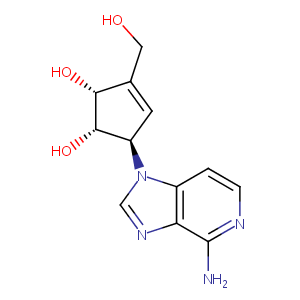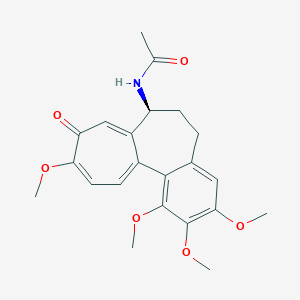| DOT Name |
DOT ID |
UniProt ID |
Mode of Action |
REF |
|
ATP-dependent translocase ABCB1 (ABCB1)
|
OTEJROBO
|
MDR1_HUMAN
|
Increases Expression
|
[18] |
|
Multidrug resistance-associated protein 1 (ABCC1)
|
OTGUN89S
|
MRP1_HUMAN
|
Decreases Response To Substance
|
[19] |
|
Succinate dehydrogenase assembly factor 1, mitochondrial (SDHAF1)
|
OTDG5VW7
|
SDHF1_HUMAN
|
Decreases Expression
|
[13] |
|
Serine/threonine-protein kinase Sgk1 (SGK1)
|
OT301T1U
|
SGK1_HUMAN
|
Decreases Expression
|
[13] |
|
E3 ubiquitin-protein ligase TRIM38 (TRIM38)
|
OT6SP1M9
|
TRI38_HUMAN
|
Decreases Expression
|
[13] |
|
Torsin-1A (TOR1A)
|
OTYCLGJU
|
TOR1A_HUMAN
|
Decreases Expression
|
[13] |
|
Ectoderm-neural cortex protein 1 (ENC1)
|
OTJEUB6U
|
ENC1_HUMAN
|
Decreases Expression
|
[13] |
|
Tumor necrosis factor receptor superfamily member 10B (TNFRSF10B)
|
OTA1CPBV
|
TR10B_HUMAN
|
Decreases Expression
|
[13] |
|
Inhibitor of nuclear factor kappa-B kinase subunit beta (IKBKB)
|
OT9RDS3H
|
IKKB_HUMAN
|
Increases Phosphorylation
|
[20] |
|
Plexin-B2 (PLXNB2)
|
OT56I2VD
|
PLXB2_HUMAN
|
Decreases Expression
|
[13] |
|
Protein phosphatase 1D (PPM1D)
|
OT8NLZ9D
|
PPM1D_HUMAN
|
Decreases Expression
|
[13] |
|
Regulator of G-protein signaling 16 (RGS16)
|
OTBKZASI
|
RGS16_HUMAN
|
Decreases Expression
|
[13] |
|
E3 ubiquitin-protein ligase RNF113A (RNF113A)
|
OTR6N7HU
|
R113A_HUMAN
|
Decreases Expression
|
[13] |
|
DNA repair protein RAD51 homolog 3 (RAD51C)
|
OTUD6SY5
|
RA51C_HUMAN
|
Decreases Expression
|
[13] |
|
TP53-regulated inhibitor of apoptosis 1 (TRIAP1)
|
OTEAUJXN
|
TRIA1_HUMAN
|
Decreases Expression
|
[13] |
|
Dual specificity protein phosphatase 14 (DUSP14)
|
OTGODFCR
|
DUS14_HUMAN
|
Decreases Expression
|
[13] |
|
Kinesin-like protein KIF20A (KIF20A)
|
OTXOQHE0
|
KI20A_HUMAN
|
Decreases Expression
|
[13] |
|
CUGBP Elav-like family member 2 (CELF2)
|
OTLJJ4VT
|
CELF2_HUMAN
|
Increases Expression
|
[21] |
|
G1/S-specific cyclin-E2 (CCNE2)
|
OTBBUKQQ
|
CCNE2_HUMAN
|
Decreases Expression
|
[13] |
|
Prothrombin (F2)
|
OTNFSM49
|
THRB_HUMAN
|
Affects Activity
|
[22] |
|
Tumor necrosis factor (TNF)
|
OT4IE164
|
TNFA_HUMAN
|
Decreases Expression
|
[23] |
|
Interleukin-1 beta (IL1B)
|
OT0DWXXB
|
IL1B_HUMAN
|
Increases Expression
|
[24] |
|
Albumin (ALB)
|
OTVMM513
|
ALBU_HUMAN
|
Affects Expression
|
[22] |
|
Glucocorticoid receptor (NR3C1)
|
OTCI2YDI
|
GCR_HUMAN
|
Increases Activity
|
[25] |
|
Transcription factor Jun (JUN)
|
OTCYBO6X
|
JUN_HUMAN
|
Increases Phosphorylation
|
[26] |
|
Keratin, type I cytoskeletal 18 (KRT18)
|
OTVLQFIP
|
K1C18_HUMAN
|
Decreases Expression
|
[27] |
|
Poly polymerase 1 (PARP1)
|
OT310QSG
|
PARP1_HUMAN
|
Increases Cleavage
|
[28] |
|
Interleukin-8 (CXCL8)
|
OTS7T5VH
|
IL8_HUMAN
|
Increases Expression
|
[24] |
|
Apoptosis regulator Bcl-2 (BCL2)
|
OT9DVHC0
|
BCL2_HUMAN
|
Decreases Expression
|
[29] |
|
Microtubule-associated protein tau (MAPT)
|
OTMTP2Z7
|
TAU_HUMAN
|
Decreases Expression
|
[30] |
|
Endoplasmic reticulum chaperone BiP (HSPA5)
|
OTFUIRAO
|
BIP_HUMAN
|
Increases Expression
|
[31] |
|
Microtubule-associated protein 2 (MAP2)
|
OT6UYT3X
|
MTAP2_HUMAN
|
Decreases Expression
|
[32] |
|
Cadherin-1 (CDH1)
|
OTFJMXPM
|
CADH1_HUMAN
|
Affects Activity
|
[33] |
|
CD59 glycoprotein (CD59)
|
OTSUMQDH
|
CD59_HUMAN
|
Increases Mutagenesis
|
[34] |
|
G2/mitotic-specific cyclin-B1 (CCNB1)
|
OT19S7E5
|
CCNB1_HUMAN
|
Increases Expression
|
[35] |
|
Matrix metalloproteinase-9 (MMP9)
|
OTB2QDAV
|
MMP9_HUMAN
|
Decreases Expression
|
[28] |
|
Tyrosine aminotransferase (TAT)
|
OT2CJ91O
|
ATTY_HUMAN
|
Decreases Expression
|
[36] |
|
Syndecan-1 (SDC1)
|
OTWKRVZC
|
SDC1_HUMAN
|
Decreases Expression
|
[13] |
|
Lactoperoxidase (LPO)
|
OTJ9QKX9
|
PERL_HUMAN
|
Decreases Expression
|
[32] |
|
Acetylcholinesterase (ACHE)
|
OT2H8HG6
|
ACES_HUMAN
|
Increases Activity
|
[37] |
|
NADPH:adrenodoxin oxidoreductase, mitochondrial (FDXR)
|
OTPDCK1F
|
ADRO_HUMAN
|
Decreases Expression
|
[13] |
|
Carnitine O-palmitoyltransferase 2, mitochondrial (CPT2)
|
OTIN6G20
|
CPT2_HUMAN
|
Decreases Expression
|
[13] |
|
NF-kappa-B inhibitor alpha (NFKBIA)
|
OTFT924M
|
IKBA_HUMAN
|
Increases Phosphorylation
|
[20] |
|
M-phase inducer phosphatase 1 (CDC25A)
|
OTSLKKCO
|
MPIP1_HUMAN
|
Decreases Expression
|
[13] |
|
GTP cyclohydrolase 1 (GCH1)
|
OTOZ6NSL
|
GCH1_HUMAN
|
Decreases Expression
|
[13] |
|
Sodium-dependent serotonin transporter (SLC6A4)
|
OT6FGDLW
|
SC6A4_HUMAN
|
Decreases Expression
|
[32] |
|
Replication factor C subunit 1 (RFC1)
|
OT3L5PK3
|
RFC1_HUMAN
|
Decreases Expression
|
[13] |
|
DNA damage-inducible transcript 3 protein (DDIT3)
|
OTI8YKKE
|
DDIT3_HUMAN
|
Increases Expression
|
[31] |
|
Aryl hydrocarbon receptor (AHR)
|
OTFE4EYE
|
AHR_HUMAN
|
Decreases Activity
|
[38] |
|
Cyclin-dependent kinase inhibitor 1 (CDKN1A)
|
OTQWHCZE
|
CDN1A_HUMAN
|
Decreases Expression
|
[13] |
|
Tumor necrosis factor ligand superfamily member 9 (TNFSF9)
|
OTV9L89D
|
TNFL9_HUMAN
|
Decreases Expression
|
[13] |
|
Serine/threonine-protein kinase mTOR (MTOR)
|
OTHH8KU7
|
MTOR_HUMAN
|
Decreases Expression
|
[32] |
|
Caspase-3 (CASP3)
|
OTIJRBE7
|
CASP3_HUMAN
|
Increases Activity
|
[29] |
|
RNA-binding protein 34 (RBM34)
|
OTX3LUGI
|
RBM34_HUMAN
|
Decreases Expression
|
[13] |
|
Mitogen-activated protein kinase 8 (MAPK8)
|
OTEREYS5
|
MK08_HUMAN
|
Increases Phosphorylation
|
[26] |
|
Mitogen-activated protein kinase 9 (MAPK9)
|
OTCEVJ9E
|
MK09_HUMAN
|
Increases Phosphorylation
|
[26] |
|
LIM/homeobox protein Lhx2 (LHX2)
|
OTK61NP8
|
LHX2_HUMAN
|
Decreases Expression
|
[13] |
|
DNA mismatch repair protein Msh6 (MSH6)
|
OT46FP09
|
MSH6_HUMAN
|
Decreases Expression
|
[13] |
|
RecQ-like DNA helicase BLM (BLM)
|
OTEJOAJX
|
BLM_HUMAN
|
Decreases Expression
|
[13] |
|
Ataxin-1 (ATXN1)
|
OTQF0HNR
|
ATX1_HUMAN
|
Decreases Expression
|
[13] |
|
Caspase-9 (CASP9)
|
OTD4RFFG
|
CASP9_HUMAN
|
Increases Activity
|
[29] |
|
Interleukin-2 (IL2)
|
OTGI4NSA
|
IL2_HUMAN
|
Decreases Expression
|
[23] |
|
Ras-related protein Rap-2b (RAP2B)
|
OTD2NDQP
|
RAP2B_HUMAN
|
Decreases Expression
|
[13] |
|
Protein BTG1 (BTG1)
|
OTVJ2CDM
|
BTG1_HUMAN
|
Decreases Expression
|
[13] |
|
Protein BTG2 (BTG2)
|
OTZF6K1H
|
BTG2_HUMAN
|
Decreases Expression
|
[13] |
|
Transcription factor E2F1 (E2F1)
|
OTLKYBBC
|
E2F1_HUMAN
|
Decreases Expression
|
[13] |
|
Myelin transcription factor 1 (MYT1)
|
OTC3660I
|
MYT1_HUMAN
|
Increases Phosphorylation
|
[38] |
|
DNA-binding protein inhibitor ID-3 (ID3)
|
OTUULW5Z
|
ID3_HUMAN
|
Decreases Expression
|
[13] |
|
Glutamate receptor ionotropic, NMDA 1 (GRIN1)
|
OTZ5YBO8
|
NMDZ1_HUMAN
|
Decreases Expression
|
[32] |
|
Apoptosis regulator BAX (BAX)
|
OTAW0V4V
|
BAX_HUMAN
|
Increases Expression
|
[29] |
|
Tripartite motif-containing protein 26 (TRIM26)
|
OTS0DJIP
|
TRI26_HUMAN
|
Decreases Expression
|
[13] |
|
E3 ubiquitin-protein ligase TRIM32 (TRIM32)
|
OTJOV0PG
|
TRI32_HUMAN
|
Decreases Expression
|
[13] |
|
Chromatin assembly factor 1 subunit A (CHAF1A)
|
OTXSSY4H
|
CAF1A_HUMAN
|
Decreases Expression
|
[13] |
|
Chromatin assembly factor 1 subunit B (CHAF1B)
|
OTOMK4KH
|
CAF1B_HUMAN
|
Decreases Expression
|
[13] |
|
DNA topoisomerase 3-alpha (TOP3A)
|
OT3CKUI9
|
TOP3A_HUMAN
|
Decreases Expression
|
[13] |
|
Oligodendrocyte transcription factor 2 (OLIG2)
|
OTMCN6D3
|
OLIG2_HUMAN
|
Decreases Expression
|
[32] |
|
Protein BTG3 (BTG3)
|
OT9ANHVT
|
BTG3_HUMAN
|
Decreases Expression
|
[13] |
|
Protein-tyrosine kinase 2-beta (PTK2B)
|
OTGAS0I8
|
FAK2_HUMAN
|
Increases Phosphorylation
|
[21] |
|
Histone RNA hairpin-binding protein (SLBP)
|
OTVYYQRT
|
SLBP_HUMAN
|
Decreases Expression
|
[13] |
|
Nuclear factor of activated T-cells, cytoplasmic 4 (NFATC4)
|
OTTDCUAO
|
NFAC4_HUMAN
|
Decreases Localization
|
[39] |
|
Neutral amino acid transporter B(0) (SLC1A5)
|
OTE2H26Q
|
AAAT_HUMAN
|
Decreases Expression
|
[13] |
|
E3 ubiquitin-protein ligase RNF19B (RNF19B)
|
OTYCWKBP
|
RN19B_HUMAN
|
Decreases Expression
|
[13] |
|
Protein MCM10 homolog (MCM10)
|
OTV0O3JN
|
MCM10_HUMAN
|
Decreases Expression
|
[13] |
|
Partner and localizer of BRCA2 (PALB2)
|
OT6DNDBG
|
PALB2_HUMAN
|
Decreases Expression
|
[13] |
|
E3 ubiquitin-protein ligase TRIM22 (TRIM22)
|
OTJBLG5R
|
TRI22_HUMAN
|
Decreases Expression
|
[13] |
|
Leucine-rich repeat-containing protein 47 (LRRC47)
|
OTSE8NAO
|
LRC47_HUMAN
|
Decreases Expression
|
[13] |
|
Protein tyrosine phosphatase type IVA 1 (PTP4A1)
|
OTK0NFXJ
|
TP4A1_HUMAN
|
Decreases Expression
|
[13] |
|
Cytochrome c oxidase assembly factor 7 (COA7)
|
OTRQJYL6
|
COA7_HUMAN
|
Decreases Expression
|
[13] |
|
Mitochondrial potassium channel (CCDC51)
|
OTOJNHNA
|
MITOK_HUMAN
|
Decreases Expression
|
[13] |
|
Aurora kinase B (AURKB)
|
OTIY4VHU
|
AURKB_HUMAN
|
Increases Expression
|
[35] |
|
Integrator complex subunit 15 (INTS15)
|
OT3O4INM
|
INT15_HUMAN
|
Decreases Expression
|
[13] |
|
Pleckstrin homology domain-containing family F member 1 (PLEKHF1)
|
OT9OL16U
|
PKHF1_HUMAN
|
Decreases Expression
|
[13] |
|
Krueppel-like factor 6 (KLF6)
|
OTQY9S7F
|
KLF6_HUMAN
|
Increases Expression
|
[13] |
|
Cell division control protein 6 homolog (CDC6)
|
OTX93FE7
|
CDC6_HUMAN
|
Decreases Expression
|
[13] |
|
Growth/differentiation factor 15 (GDF15)
|
OTWQN50N
|
GDF15_HUMAN
|
Decreases Expression
|
[13] |
|
Protein orai-3 (ORAI3)
|
OTUP3OH3
|
ORAI3_HUMAN
|
Decreases Expression
|
[13] |
|
Protein pelota homolog (PELO)
|
OTF3WLIM
|
PELO_HUMAN
|
Decreases Expression
|
[13] |
|
TIMELESS-interacting protein (TIPIN)
|
OT9PZHXV
|
TIPIN_HUMAN
|
Decreases Expression
|
[13] |
|
Angiotensin-converting enzyme 2 (ACE2)
|
OTTRZGU7
|
ACE2_HUMAN
|
Decreases Expression
|
[40] |
|
tRNA pseudouridine(38/39) synthase (PUS3)
|
OT6WG6M2
|
PUS3_HUMAN
|
Decreases Expression
|
[13] |
|
Transmembrane protein 185B (TMEM185B)
|
OTGNYS0J
|
T185B_HUMAN
|
Decreases Expression
|
[13] |
|
Interferon-stimulated 20 kDa exonuclease-like 2 (ISG20L2)
|
OT3Q11WQ
|
I20L2_HUMAN
|
Decreases Expression
|
[13] |
|
GrpE protein homolog 1, mitochondrial (GRPEL1)
|
OT8O00YJ
|
GRPE1_HUMAN
|
Decreases Expression
|
[13] |
|
p53-induced death domain-containing protein 1 (PIDD1)
|
OTWFM930
|
PIDD1_HUMAN
|
Decreases Expression
|
[13] |
|
Fructose-2,6-bisphosphatase TIGAR (TIGAR)
|
OTR7NMRJ
|
TIGAR_HUMAN
|
Decreases Expression
|
[13] |
|
DNA damage-inducible transcript 4 protein (DDIT4)
|
OTHY8SY4
|
DDIT4_HUMAN
|
Decreases Expression
|
[13] |
|
Forkhead box protein J2 (FOXJ2)
|
OTPT639J
|
FOXJ2_HUMAN
|
Decreases Expression
|
[13] |
|
Homologous-pairing protein 2 homolog (PSMC3IP)
|
OT9UB5UO
|
HOP2_HUMAN
|
Decreases Expression
|
[13] |
|
Protein CLN8 (CLN8)
|
OT0D4CB5
|
CLN8_HUMAN
|
Decreases Expression
|
[13] |
|
rRNA methyltransferase 2, mitochondrial (MRM2)
|
OTRYA1HU
|
MRM2_HUMAN
|
Decreases Expression
|
[13] |
|
Frizzled-1 (FZD1)
|
OTZATHVS
|
FZD1_HUMAN
|
Decreases Expression
|
[13] |
|
SH3 and multiple ankyrin repeat domains protein 2 (SHANK2)
|
OTSQTPFQ
|
SHAN2_HUMAN
|
Decreases Expression
|
[32] |
|
5'-AMP-activated protein kinase subunit beta-1 (PRKAB1)
|
OT1OG4QZ
|
AAKB1_HUMAN
|
Decreases Expression
|
[13] |
|
Pleckstrin homology-like domain family A member 3 (PHLDA3)
|
OTXFUDO2
|
PHLA3_HUMAN
|
Decreases Expression
|
[13] |
|
Sestrin-1 (SESN1)
|
OTSFDZWL
|
SESN1_HUMAN
|
Decreases Expression
|
[13] |
|
RalA-binding protein 1 (RALBP1)
|
OTBIGB1D
|
RBP1_HUMAN
|
Affects Transport
|
[41] |
|
ATP-binding cassette sub-family A member 13 (ABCA13)
|
OTTHTUQN
|
ABCAD_HUMAN
|
Affects Response To Substance
|
[42] |
| ------------------------------------------------------------------------------------ |
|
|
|
|


